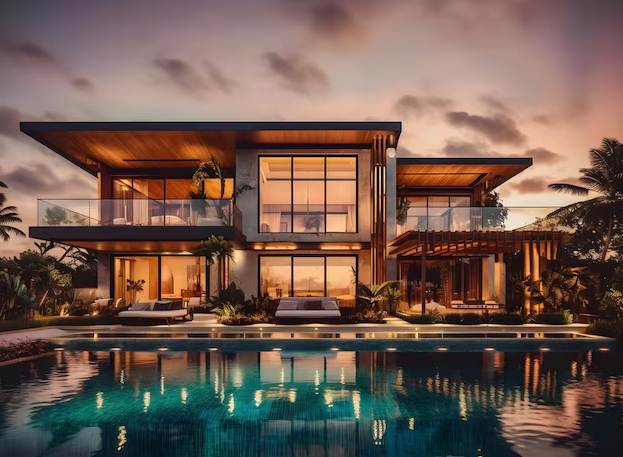As the luxury property market continues to grow in the United States, understanding its nuances becomes essential for investors and homeowners alike. This thriving sector presents unique opportunities and challenges that warrant a keen analysis to navigate successfully.
In this blog post, we’ll delve into the various aspects of high-end real estate in America, from market trends and geographical hotspots to investment strategies and future prospects. Join us as we explore what makes luxury properties a compelling choice for those looking to make a substantial and rewarding investment.
Current trends in the high-end real estate market

The luxury property sector has seen a significant evolution over recent years. An increased demand for spacious homes equipped with the latest amenities stands out as a major trend. The pandemic further accelerated this shift, with more people desiring larger living spaces.
Remote working has changed the way we live and work, prompting a migration from densely populated cities to suburban and rural areas. These areas often offer larger lots, more privacy, and better value for money, making them attractive for luxury homebuyers.
Moreover, sustainability and smart home technology have become critical selling points. High-end buyers are increasingly looking for properties that incorporate eco-friendly features and advanced home automation systems, reflecting broader societal trends toward sustainability and technological integration.
Geographical hotspots for upscale real estate
Geographically, certain regions in the United States stand out as prime locations for luxury real estate. Coastal areas like California and Florida remain perennial favorites due to their scenic beauty, favorable climate, and affluent communities.
California cities such as Los Angeles and San Francisco offer unique cultural experiences and are home to some of the most exclusive neighborhoods in the country. Meanwhile, Florida’s Miami has gained prominence for its luxurious waterfront properties and vibrant lifestyle.
In addition to these traditional hotspots, emerging areas like Texas and Colorado are also attracting high-end buyers. Cities such as Austin and Denver offer a blend of urban sophistication and outdoor adventure, appealing to a new generation of affluent homeowners.
Investment strategies for the affluent market
Navigating the upscale property market successfully requires well-thought-out investment strategies. One effective approach is diversification, where investors spread their capital across multiple high-end properties in different locations.
This strategy reduces risk and maximizes potential returns. Another key tactic is focusing on properties with unique or scarce features, such as waterfront access, historical significance, or special architectural designs. These characteristics often command premium prices and appreciate well over time.
Long-term holding is another favored strategy among luxury property investors. Given the consistent appreciation of high-end real estate, holding onto an investment for an extended period can yield substantial returns, especially in prime markets with high demand and limited supply.
Future prospects and challenges
The future of the luxury property market in the United States looks promising, though not without challenges. Economic factors, demographic shifts, and technological advancements will shape the coming years significantly.
On the positive side, the continued proliferation of remote work and technological innovations will likely sustain the demand for luxury homes. Investors and homeowners who stay ahead of trends in smart home technology and eco-friendly designs will find themselves in advantageous positions.
However, potential challenges include economic downturns or policy changes that could impact property values. Being adaptable and well-informed will be essential to navigate these uncertainties. Investors should also monitor housing market regulations and adjust their strategies accordingly.
The impact of technology and innovation
Technology continues to reshape the luxury property landscape. From virtual property tours to blockchain-based real estate transactions, the industry embraces digital transformation to enhance buyer experiences and streamline processes.
Smart home technology, including automated lighting, security systems, and energy-efficient appliances, is increasingly in demand. Properties equipped with these features are not only more appealing but also command higher prices in the market.
Additionally, technological advancements in construction methods and materials are enabling more sustainable and efficient building practices. These innovations benefit both developers and homebuyers by reducing costs and environmental impact.
Demographic shifts and their influence
Demographic changes are another significant factor shaping the luxury property market. Millennials and Generation Z are beginning to enter the high-end real estate market, bringing different preferences and expectations compared to previous generations.
These younger buyers value unique experiences, convenience, and sustainability. As a result, luxury properties that offer these attributes are becoming increasingly popular. Real estate developers need to cater to these evolving preferences to stay competitive.
Moreover, the aging baby boomer generation is downsizing and relocating to upscale communities that offer amenities and services tailored to active retirees. This trend is creating new opportunities and challenges for the luxury housing market.






